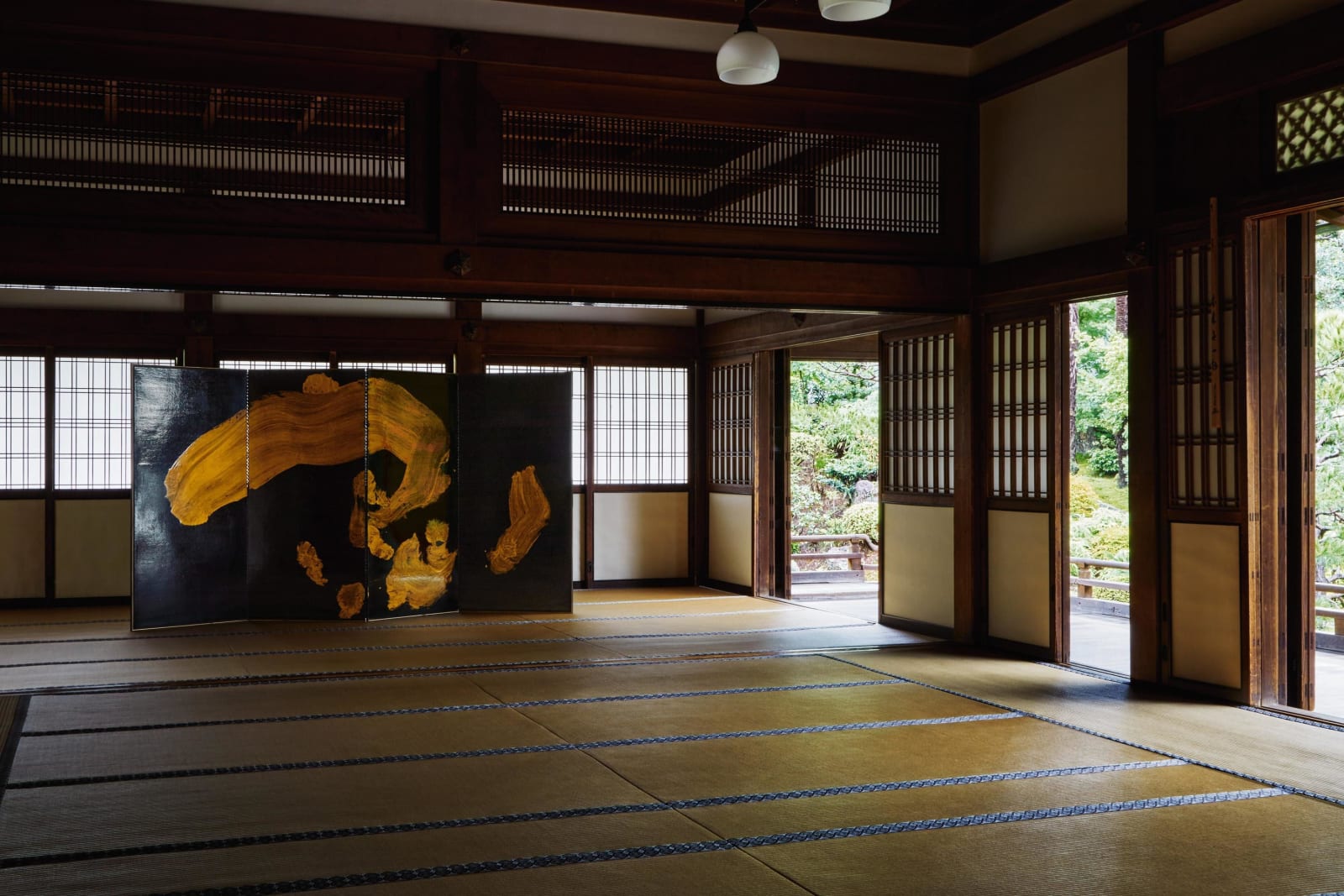Morita Shiryū (1912–1998)
Kanzan
Aluminum flake pigment and lacquer on paper, four-panel folding screen
1969
With a label signed by the artist
162 x 310 cm (overall)
1969
With a label signed by the artist
162 x 310 cm (overall)
Exhibitions
Solo exhibition. Ottawa: The National Gallery of Canada; traveling exhibition throughout Canada, 1969.Literature
The Works of Shiryu Morita: Selected by the Artist. Kyoto: Bokubisha, 1971.Morita Shiryu Catalogue Raisonné: 1952–1998. Uji: Soryusha, 2019.
As with 1964’s Ryu wa ryu wo shiru, Morita relies on aluminum flake pigment in glue medium with a transparent lacquer coating for this four-panel folding screen, Kanzan. A work from the same period and with the same characters, but done in ink on paper, is now in the collection of the Kyoto City Museum of Art. In contrast to the version in ink, the present Kanzan’s layer of a lacquer reinforces the traces of brush movement on the work’s surface. Morita tried the shikkin (lacquer and gold) technique for the first time at the Bokujinkai Group Exhibition of 1963.
Often that movement of the brush that Morita demonstrates so vigorously becomes the true subject matter of his works, from the moment it reaches the paper to when the stroke ends. Its twisting and turning, and the intervals between separate characters that he abbreviates are setting the whole surface of the paper into motion. The reaction of the lacquer with the aluminum pigment makes the latter appear golden, providing the work with a striking appearance that highlights its texture and rhythm. What remains to the viewer is to read the work by following the traces of the writer’s brush.
Morita Shiryu (avant-garde calligrapher; 1912–1998)
Avant-garde calligrapher from Hyogo Prefecture. Like fellow artist Inoue Yuichi, Morita studied under the calligraphy master Ueda Sokyu. He co-founded the avant-garde group Bokujinkai together with Inoue and was the founder and editor of the journal Bokubi (Beauty of Ink), both of which revolutionized traditional Japanese calligraphy and spread knowledge of Japanese avant-garde calligraphy to an international audience. He was posthumously awarded the Medal of Honor with Dark Blue Ribbon.
Often that movement of the brush that Morita demonstrates so vigorously becomes the true subject matter of his works, from the moment it reaches the paper to when the stroke ends. Its twisting and turning, and the intervals between separate characters that he abbreviates are setting the whole surface of the paper into motion. The reaction of the lacquer with the aluminum pigment makes the latter appear golden, providing the work with a striking appearance that highlights its texture and rhythm. What remains to the viewer is to read the work by following the traces of the writer’s brush.
Morita Shiryu (avant-garde calligrapher; 1912–1998)
Avant-garde calligrapher from Hyogo Prefecture. Like fellow artist Inoue Yuichi, Morita studied under the calligraphy master Ueda Sokyu. He co-founded the avant-garde group Bokujinkai together with Inoue and was the founder and editor of the journal Bokubi (Beauty of Ink), both of which revolutionized traditional Japanese calligraphy and spread knowledge of Japanese avant-garde calligraphy to an international audience. He was posthumously awarded the Medal of Honor with Dark Blue Ribbon.



